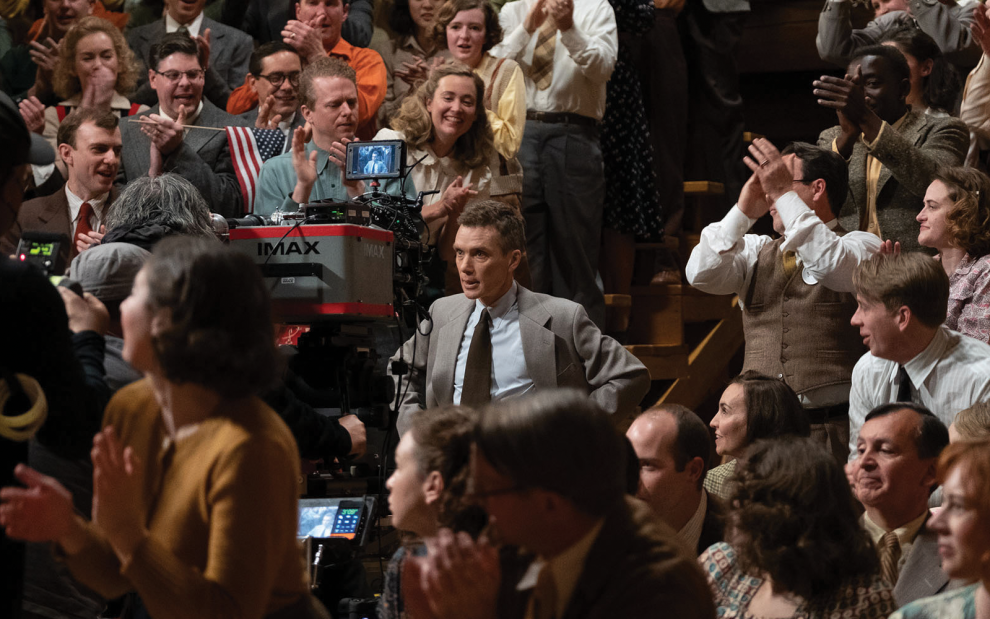Who’d have thought that Oppenheimer—a sprawling, three-hour-long, demanding, and often disturbing movie about the physicist behind the first atom bomb—could possibly become a summer Cineplex phenomenon? The reputation of director Christopher Nolan, who made the Dark Knight Batman trilogy, certainly helped. But let’s face it, a work like this might not have broken even if it weren’t for all the Barbenheimer buzz on social media.
Still, a win’s a win. In the last few months, millions of our fellow Americans have confronted the darkness at the heart of American greatness and the tragedy that lies behind our greatest triumphs. And we can only be better off for that.
As depicted in the film by an appropriately gaunt and bug-eyed Cillian Murphy, J. Robert Oppenheimer embodies those American contradictions. The film’s barely begun when we see him both plotting a despicable act of revenge against a college instructor and dazzling European lecture audiences. Back in the United States, we find him comfortably ensconced at the University of California, Berkeley, enjoying the hero worship of his students and undergoing affairs with colleagues’ wives. That’s when he’s offered the opportunity to take a lead role in the war against Nazism.
Oppenheimer started the Los Alamos, New Mexico, atomic research site in 1942, but the development of a working bomb took three years. During that time, the Allies defeated Hitler the hard way, inch by inch and body by body. Still, when the bomb was finally ready, U.S. military leadership was determined to use it to shorten the war against Japan, which wasn’t what Oppenheimer’s scientific team had signed up for.
Oppenheimer himself, in the movie and in real life, never publicly expressed regret about the slaughter of Japanese civilians at Hiroshima and Nagasaki. In the movie we see him carefully tiptoe around the issue. Much later, in a 1965 interview with a CBS reporter, he was still hedging his bets. Asked if the atomic bombings were necessary, he said he was “not . . . confident that a better course was then open.”
The movie reveals one key to this tragic ambivalence at the center of Oppenheimer’s character: He wanted very badly to be an insider. In the 1930s, he dabbled in then-fashionable left-wing politics but refused to actually join the Communist Party, thus preserving his respectable perch in the academy. Later, at Los Alamos, when ordered to wear a military uniform he did it until a fellow scientist told him he looked ridiculous. After the successful test of the atomic bomb in July 1945, many of Oppenheimer’s closest colleagues drafted a petition asking President Truman not to use the bomb on Japan. Oppenheimer delivered the petition and communicated their concerns, but he didn’t join them.
After the A-bomb ended the war, Oppenheimer was a national hero and used that status to try to steer U.S. policy toward international arms control. But once the wartime alliance with the Soviet Union ended, Oppenheimer’s Depression-era leftism made him an outsider.
In that 1965 CBS interview, Oppenheimer elaborated on his earlier statement that, with the development of the atomic bomb, the “physicists had known sin.” He explained that, to him, the sin was not the deaths in Japan but the sin of pride.
That sin is on ample display today among the scientists and corporations whose damn-the-torpedoes approach to developing artificial intelligence (AI) may be hurtling us toward an apocalypse.
Many AI scientists frankly admit that their work could have devastating consequences. Aside from triggering mass unemployment and deepening economic inequality, AI experts acknowledge that their programs are now evolving on their own in ways that they can neither predict nor control. Many of these experts say it is likely these systems will learn how to defy human commands and refuse to be turned off, like HAL at the end of 2001: A Space Odyssey.
In a recent Atlantic magazine profile, OpenAI chief Sam Altman admitted there is even a chance that AI systems could, on their own, cook up some new pathogen that would lead to human extinction. He says various scientists put the odds of extinction at anywhere from .5 to 50 percent.
Many of these AI scientists issue statements urging government to regulate them but at the same time accelerate the pace of their work. As we see in the film, Oppenheimer and his Los Alamos colleagues had similar qualms, which they similarly ignored. But that’s where the comparison ends. The Los Alamos scientists were working to win a war, to save Jews and the other minorities and nationalities Hitler targeted. And their project was initiated and controlled by elected government officials who were at least trying to serve the national interest and the common good.
Whom do the wizards of AI serve? Well, Sam Altman and OpenAI mostly serve Microsoft.
Whatever we can say about the madness of the Cold War and the resulting nuclear arms race, it was at least subject to some measure of public scrutiny and debate. Developments that could be equally dangerous are going on today without any form of public oversight and solely in the interest of private profit.
Microsoft has incorporated OpenAI’s ChatGPT into the search engine that comes with every Windows computer. Google is racing to do the same. Meta (formerly Facebook) is opening all of its AI research to the public to be used by anyone, for anything.
Oppenheimer thought that the atomic bomb had to be used because when people saw how horrible it was, it would never be used again. Surprisingly enough, that has happened. Today nine nations have nuclear weapons, but, since Nagasaki, they have never been used.
We may not get that lucky again.
For more perspectives on artificial intelligence . . .
- Futuristic fiction asks important ethical questions about AI
- AI isn’t all doom and gloom, says this theologian
- How should Christians respond to the challenges of AI?
This article also appears in the November 2023 issue of U.S. Catholic (Vol. 88, No. 11, pages 36-37). Click here to subscribe to the magazine.
Image: Universal Pictures














Add comment